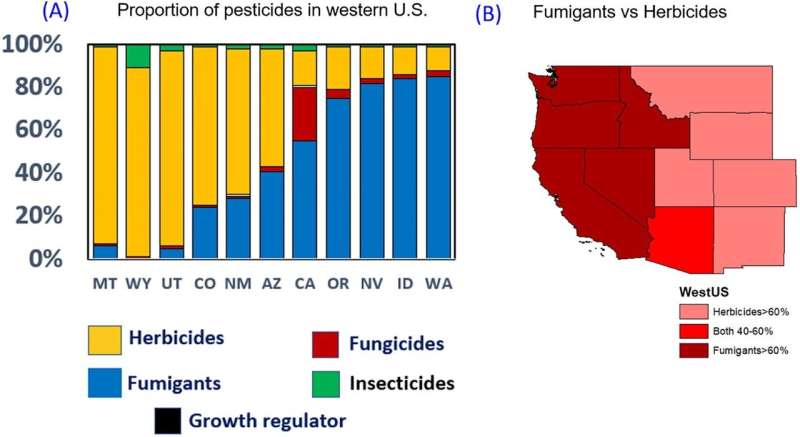(a) Proportion of pesticide usage by state and (b) Spatial map of fumigant and herbicide proportion by state in the Western United States. Credit: GeoHealth (2022). DOI: 10.1029/2021GH000544
Around the world, farmers each year coat their fields in hundreds of millions of pounds of herbicides, insecticides, fungicides, and fumigants. These chemical treatments effectively take care of crop-damaging pests, but many have negative side effects for people and other animals in the ecosystem. Over the past half century, many pesticides, such as DDT, have been banned because of their health and environmental impacts. However, farmers in the United States still use dozens of chemicals that have been outlawed in other countries.
Previous studies have found a likely link between cancer rates and some of the pesticides still applied today. Most of this research, however, has focused on specific case studies of exposed agricultural workers. Naveen Joseph and a research team study how simply being at risk of pesticide exposure affects people's health. The team looked at cancer and pesticide data across the 11 westernmost U.S. states to see whether any connections might emerge between higher cancer rates and the use of certain types of agricultural chemicals.
The study, published in GeoHealth, revealed a connection between cancer rates and fumigants. The higher the mass of fumigants applied in a region, the higher the rate of pediatric cancer. Two widely used soil fumigants—metam sodium and metam potassium—were also linked to an overall higher prevalence of cancer. The carcinogenic influence of metam salts could happen after their application to the soil, when they break down into more toxic chemicals and spread through the air. Conversely, researchers did not find a connection between cancer risk and amount of herbicide applied.
Although the results of this study represent only correlations, they demonstrate a need for further investigation, according to the authors. These results could be used to identify areas in the West that require more public health attention. The authors also suggest that future studies should investigate the link between metam, the chemicals it breaks down into, and cancer.
More information: Naveen Joseph et al, Investigation of Relationships Between the Geospatial Distribution of Cancer Incidence and Estimated Pesticide Use in the U.S. West, GeoHealth (2022). DOI: 10.1029/2021GH000544
Provided by American Geophysical Union
This story is republished courtesy of Eos, hosted by the American Geophysical Union. Read the original story here.























